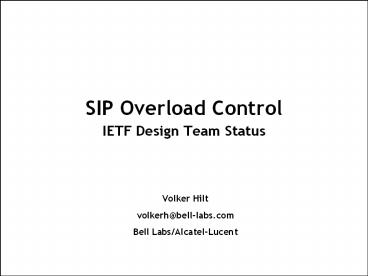Volker%20Hilt - PowerPoint PPT Presentation
Title:
Volker%20Hilt
Description:
Eric Noel, Carolyn Johnson (AT&T Labs) Volker Hilt, Fangzhe Chang (Bell Labs/Alcatel-Lucent) ... Underload: 114 cps. Overload: 500 cps, 1000 cps. Results ... – PowerPoint PPT presentation
Number of Views:38
Avg rating:3.0/5.0
Title: Volker%20Hilt
1
SIP Overload ControlIETF Design Team Status
- Volker Hilt
- volkerh_at_bell-labs.com
- Bell Labs/Alcatel-Lucent
2
SIP Overload Control Design TeamCurrent Status
- Team Members
- Eric Noel, Carolyn Johnson (ATT Labs)
- Volker Hilt, Fangzhe Chang (Bell
Labs/Alcatel-Lucent) - Charles Shen, Henning Schulzrinne (Columbia
University) - Ahmed Abdelal, Tom Phelan (Sonus Networks)
- Mary Barnes (Nortel)
- Jonathan Rosenberg (Cisco)
- Nick Stewart (British Telecom)
- Four independent simulation tools
- ATT Labs, Bell Labs/Alcatel-Lucent, Columbia
University, Sonus Networks - Bi-weekly conference calls.
3
draft-ietf-sipping-overload-design-00Status and
Changes
- Status
- Submitted as SIPPING WG item.
- Changes to draft-hilt-sipping-overload-design-00
- Numerous clarifications throughout the text
- Added separate section for problem description
- Added an overload control mechanism
- Overload signal-based overload control
- Discussion of implicit overload control in
separate section.
4
draft-ietf-sipping-overload-design-00Next Steps
- Document investigates design choices and models.
- Document is stable.
- Simulation results are not included.
- Ready for WGLC?
5
Simulation Results Overload Control Feedback
Types
- Rate-based Overload Control
- Limit the request rate a server receives from an
upstream element. - Feedback X requests per second.
- Loss-based Overload Control
- Reduce the request rate a server receives by a
percentage X. - Feedback reduce load by X.
- Window-based Overload Control
- Limit the number of request a server can receive
without confirming a request. - Feedback send X more requests.
- Overload Signal-based Overload Control
- De-/increase of request rate until a target
overload notification rate is reached. - Feedback server overloaded (503 response without
RetryAfter header)
6
Simulation ResultsNo Overload Control
- Simulation Setup
- Evaluate SIP overload performance under varying
network conditions. - Network delay 0 2 sec
- Network loss 0 50
- Topology consists of 5 edge proxies and 2 core
proxies. - Overall capacity 142 cps
- Three levels of offered load
- Underload 114 cps
- Overload 500 cps, 1000 cps
- Results
- Delay and loss substantially decrease goodput
even when there is no overload. - Confirmed by all simulators (ATT Labs, Bell
Labs/Alcatel-Lucent, Columbia University, Sonus
Networks)
7
Simulation ResultsUpper Bound Estimation
- Delay and loss triggers retransmissions.
- Increases the number of SIP messages needed to
set up a call. - Causes the goodput of a server drops.
- Upper bound estimation
- Determine increase in message count caused by
delay/loss. - Example topology UAC proxy - UAS
- Calculate resulting goodput.
- Example result 125 ms delay
- Round trip delay exceeds 500ms.
- One 200 OK/ACK retransmission and one BYE/200 OK
retransmission triggered. - Messages per call increases from 7 to 11.
- Contributor ATT Labs
8
Simulation ResultsSelected Results on Overload
Control (1)
Rate-based Control
Loss-based Control
ATT Labs
Bell-Labs/Alcatel-Lucent
9
Simulation Results Selected Results on Overload
Control (2)
Overload Signal-based Control
Window-based Control
Sonus Networks
Columbia University
10
Conclusions and Next Steps
- Conclusions
- Large delay and loss rates can cause the goodput
to drop substantially even in non-overloaded
conditions. - Performance of all overload control mechanisms
under evaluation is similar in steady state. - Varying network conditions do not reveal
significant differences. - Next Steps
- Evaluate additional scenarios.
- Impact of different load distributions
- Impact of varying upstream neighbor counts
- Transient simulations.
- Evaluate dynamic behavior of overload control
mechanisms - Transition in/out of overload, impact of load
peaks, etc. - Evaluate fairness of overload control mechanisms.
11
SIP Overload Control Design TeamPublications
- E. Noel, C. Johnson, Initial Simulation Results
That Analyze SIP Based VoIP Networks Under
Overload, International Teletraffic Congress
(ITC07), Ottawa, Canada, June 2007. - C. Shen, H. Schulzrinne, E. Nahum, Session
Initiation Protocol (SIP) Server Overload
Control Design and Evaluation, Principles,
Systems and Applications of IP Telecommunications
(IPTComm08), Heidelberg, Germany, July 2008. - V. Hilt, I. Widjaja, Controlling Overload in
Networks of SIP Servers, IEEE International
Conference on Network Protocols (ICNP08),
Orlando, Florida, October 2008.





























